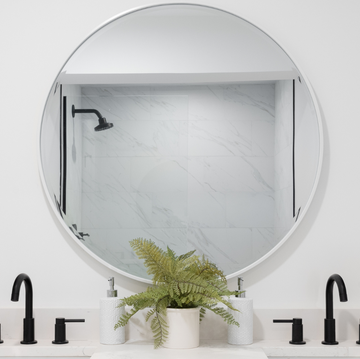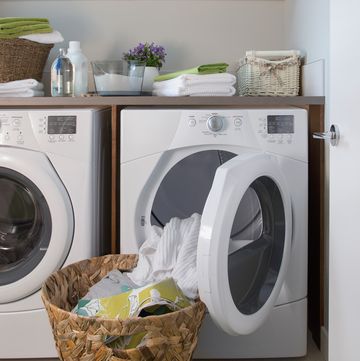Some people swear you should only hand wash your favorite pair of jeans. Others say you shouldn't wash them at all. But most of us just toss this wardrobe staple in the washing machine along with the rest of our laundry without thinking twice.
So what's the best thing to do? We’ve tested all kinds of denim fabrics and detergents in our Good Housekeeping Institute Cleaning and Textiles Labs, and we recommend you wash denim after every three to four wears or so to keep your basic dark blue and black jeans clean, fitting well, and looking new for as long as possible.
The Best Way to Wash Jeans
New or old, you should always turn jeans inside out before placing them in the washing machine. This helps minimize the abrasion that causes fading as well as the wear that can happen along the hems, pockets, and fly and waistband edges. It’s also important to zip zippers and fasten buttons and snaps — this helps keep the jeans in shape and prevents snagging other items in the load.
For ripped jeans with frayed hems or holes, clip the openings or edges together with a clip like Sock Cops. Designed to keeps socks paired up in the wash, these clever clips can also help keep denim from fraying more than you want it to. (If your jeans are really ripped, they will fare better with hand washing.)
Use a detergent designed to preserve colors like Woolite Darks Liquid Laundry Detergent or Tide Studio Darks and Colors. They contain ingredients to help fabrics hold onto dyes and to deactivate the chlorine in the water that can fade colors. Finally, it's best to wash jeans in cold water on a short, delicate cycle.
The Best Way to Dry Jeans
When it comes to drying jeans, be sure to turn your pair inside out and tumble dry them on a delicate cycle and low heat setting, unless the care label directs otherwise. Toss in a few dryer balls to help keep them tumbling so they’ll dry more evenly.
Plus, jeans will actually last longer and stay in shape better if you take them out of the dryer when they're slightly damp. Simply tug them into shape, smooth out the wrinkles, hang your jeans and let them air dry. Over-drying them in the machine can cause jeans to shrink and too high a temperature can dry out and damage any spandex or elastane in the fabric that gives it stretch. If your jeans have more than 3% spandex in the fabric blend, you may want to line dry them instead.
More Tips for Washing Denim Fabrics
Avoid cramming the washer and dryer full. The more garments you stuff into a load, the faster you'll get laundry done, but the more wear and tear your fabrics will endure. Without room to move, zippers and rivets can snag, and stitching can break. Your clothes should circulate or tumble freely, so they are thoroughly cleaned and dried and don't emerge from the machines in a tangled knot.
Remove stains promptly. Spot clean stains so that you’ll get more wears between launderings and your jeans will spend less time in the washer and dryer. Win!
Separate light and dark jeans. You may think that it’s safe to wash all your jeans together in one load but do so and the extra dye often put on dark denim to make it look dark can transfer to light-colored fabrics. It’s best to wash and dry them in separate loads. And be cautious when carrying light colored purses or sitting on light upholstery while wearing new dark jeans. The color that rubs off may be impossible to remove from these other items. Test by rubbing a white cloth on new super dark or black jeans to see if any color comes off (this is called crocking). If it does, consider washing them once or twice before wearing.
Carolyn Forté brings more than 40 years of experience as a consumer products expert to her role as executive director of the Good Housekeeping Institute's Home Care and Cleaning Lab. Using deep analytical testing and writing expertise in appliances, cleaning, textiles and organizational products, she produces cleaning and home care advice for GH, has authored numerous books and bookazines for the brand and partners with the American Cleaning Institute to co-produce the Discover Cleaning Summits. She holds a bachelor's degree in family and consumer sciences from Queens College, City University of New York.

















